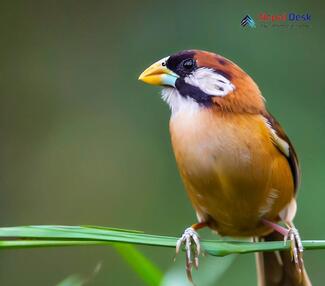Nestled among the breathtaking Himalayan mountains and lush landscapes, Nepal is a birdwatcher's paradise. Home to over 800 species of birds, it offers countless birding opportunities for both amateur and experienced enthusiasts. One of the rare and highly sought-after species is the enigmatic Black-breasted Parrotbill (Paradoxornis flavirostris). In this blog post, we explore this fascinating bird and reveal where to find them in Nepal.
A Unique Species with Distinct Features
The Black-breasted Parrotbill is a small, passerine bird that belongs to the Sylviidae family. It sports a striking black bib on its breast, giving it its name. The rest of its plumage boasts shades of grayish-brown and white, helping it blend seamlessly into its natural habitat.
Notably, it has a robust, yellowish bill that lends to its other moniker - the Yellow-billed Parrotbill. This uniquely shaped bill helps these birds extract seeds from grasses with ease, making it a vital adaptation for their survival.
Elusive Habitat: A Challenge for Birdwatchers
Typically found in the dense grasslands along rivers and swamps at altitudes of up to 1,500 meters, this elusive bird hugs the borders of Nepal and India. Its preferred habitat includes tall grasses like Phragmites karka and Saccharum spp., making it difficult to spot as it weaves through these towering plants.
Conservation Efforts
Due to rapid habitat loss in recent years, the Black-breasted Parrotbill has been classified as Near Threatened by the International Union for Conservation of Nature (IUCN). Grasslands are often converted into agricultural land or degraded by overgrazing livestock. Conservation organizations in Nepal are actively working to protect and conserve the country's vital grassland areas, to help protect this unique bird species and many others that call these zones home.
Birdwatching Tips
If you are passionate about spotting this elusive gem in its natural habitat, here are a few tips to increase your chances for success:
Timing is crucial - The ideal time to visit Nepal for birdwatching is between October and March when migratory birds are in abundance. However, you can still spot resident species, like the Black-breasted Parrotbill, during other months of the year.
Hire a local guide - Local guides are invaluable resources when it comes to birdwatching in unfamiliar territories. Their knowledge of the landscape allows them to identify potential habitats and pinpoint areas where the Black-breasted Parrotbill is known to thrive.
Remain patient - Birdwatching requires perseverance, patience, and a keen eye. Do not expect immediate results – instead, enjoy the harmonious blend of nature as you conduct your search.
Embarking on a birdwatching expedition to observe the Black-breasted Parrotbill invariably takes adventurers into the heart of Nepal's spectacular landscapes and offers an immersive experience with nature. Keep these tips in mind as you journey through this vibrant country in search of a magnificent sighting that will reward your dedication with lasting memories.

